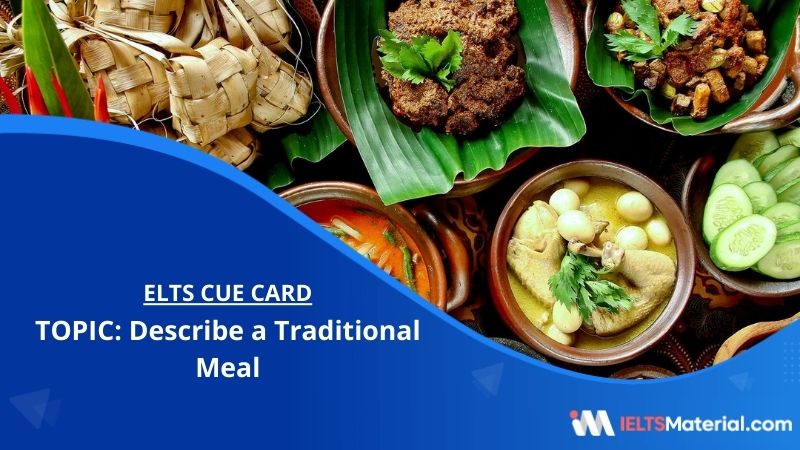Describe a Traditional Meal – IELTS Cue Card
Table of Contents

Limited-Time Offer : Access a FREE 10-Day IELTS Study Plan!
Describe a traditional meal
You should say:
- What it is?
- How do you prepare it?
- What ingredients are used to prepare it?
- And explain why you enjoy it.
Sample Answer 1
India’s land of diversity has always been a center stage of surprises for the world. The languages, communities, climates, customs, traditions, and, most significantly, cuisines keep intriguing people from all over the world. Himachal Pradesh, often known as the Devbhoomi or Land of Gods, is one such state that provides a diverse range of cuisines. These cuisines serve as a focal point for epicures while reflecting India’s vast and varied culture.
Siddu is one of the most loved foods in Himachal Pradesh. This local side is made from wheat flour and served to complement main course meals, including vegetables and/or mutton. Siddu is a meal that is difficult and time-consuming to create in Himachal Pradesh’s cuisine tradition. However, the efforts are worth it for the taste that it renders.
The dough for this traditional Himachali steamed bun is produced from wheat flour, salt, sugar, ghee, and yeast, and the filling is traditionally formed by crushing walnuts, almonds, and poppy seeds into smooth pastes separately. After the little roundels of dough have been filled with fillings, they are placed on direct heat to cook for half an hour. Following that, the buns are steamed for at least 15-20 minutes before serving.
Since I was a youngster, this dish has always appealed to me, and it is frequently served at festivals. So, mentally and in terms of flavor, I enjoy eating this meal. Our people are skilled at producing delectable dishes, and we appreciate it as a traditional supper. Because I reside in a city far away from our hometown, I don’t always have the opportunity to have this dish. So, when I’m in my hometown for the festival, I truly ensure to have this dish.
Sample Answer 2
India, with its incredible variety of spices, is home to millions of delicacies. In every nook and corner of the country, one can find a variety of food to challenge their taste buds and sense of smell. As I have a sweet tooth, I am going to share my favorite sweet dish – payesh. It is a traditional dish in India that is prepared during special occasions like birthdays, marriages, baby showers, or any important celebration as prasad. As far as I can remember, I came across it on my first birthday and instantly fell in love with the tasty dish.
[do_widget id=custom_html-22]
Payesh is a rice-based pudding and is known by different names in different parts of the country. It can be the kheer of North India or the payasam of the South. It has a very subtle taste and the basic ingredients are ghee, rice, milk, and sugar. It has a thick consistency and is normally white in color. Some of the ingredients may vary depending on the taste of the maker or the occasion or season in which it is made. Rice is considered sacred as it represents the prosperity of the country and as a result, it is part of every auspicious event. A special type of rice named gobindo-bhog, which is short-grain rice with a pleasing fragrance is used by the people of Bengal. But nowadays, rice is being replaced by vermicelli, millet, or even oats which are considered one of the healthy options by most Indians today.
Sugar is also losing its position to other sugar-free supplements and jaggery due to the health-conscious youth. To add flavor to the main dish, a variety of items are used like almonds or other dry fruits, coconut, cardamom, saffron, cinnamon powder, or other dairy products like quark. Sometimes, rose water and rose petals are added to give the dish an aromatic touch and make it as pleasing to the eyes as to the tongue.
Kheer or payesh takes about forty-five minutes to one hour to prepare. The process is quite simple. The maximum time is needed to boil the milk properly. The ghee is heated before the milk is poured into it. Until the milk starts boiling and the consistency thickens, the rice cannot be poured into it. When the milk is ready, the rice is put into it and is left like that until it has become soft. Frequent stirring is required during the process so that the food is not burnt at the bottom. Ultimately, the sugar is added and mixed well with the rice and the milk. When the payesh is ready, the other savory ingredients like raisins, cashews, and coconut are added before taking it down from the oven. The end product can be decorated with crushed nuts and rose petals on the top.
[do_widget id=custom_html-47]
Payesh is normally served either in the beginning, that is, if it has been offered to the gods during worship, or at the end as a sweet dish to end the feast with sweet memories. I like this preparation because it is quite simple to make compared to the other sweet dishes. In spite of that, the taste is mouth-watering and the aroma of the rice and milk mixed together will tease all your senses. I feel that it is best eaten cold and it will leave you wanting more.
Vocabulary
- delicacies – something pleasing to eat that is considered rare or luxurious
Eg: The royal chef prepared a number of delicacies from all over the world for the Prince’s birthday. - Nook and corner – in all the places or corners
Eg: My sister looked for her favorite dress in every nook and corner of her room, but could not find it. - consistency – the way in which a substance holds together; thickness
Eg: The batter of the cake did not have the right consistency and so the cake became sloppy. - Auspicious – attended by good fortune
Eg: On the auspicious occasion of Ganesh Chaturthi, she bought her own house. - Quark – a type of low-fat curd cheese
Eg: The doctor told Meena to feed quark to her daughter every day when she fell ill.
Related Cue Cards
Also check :

Start Preparing for IELTS: Get Your 10-Day Study Plan Today!
Recent Articles

Haniya Yashfeen

Kasturika Samanta

Nehasri Ravishenbagam





Post your Comments